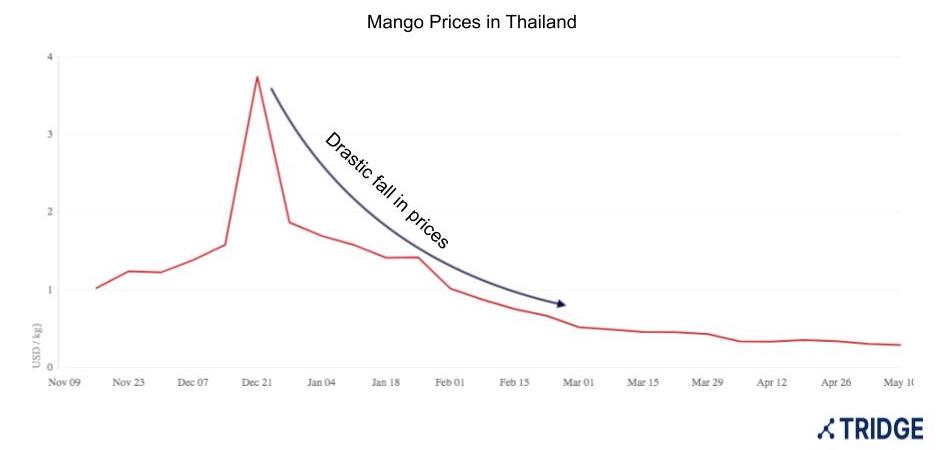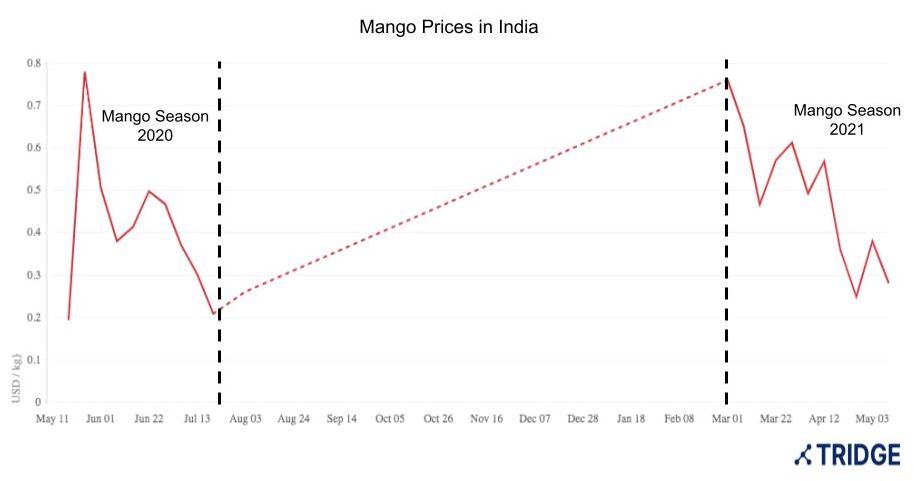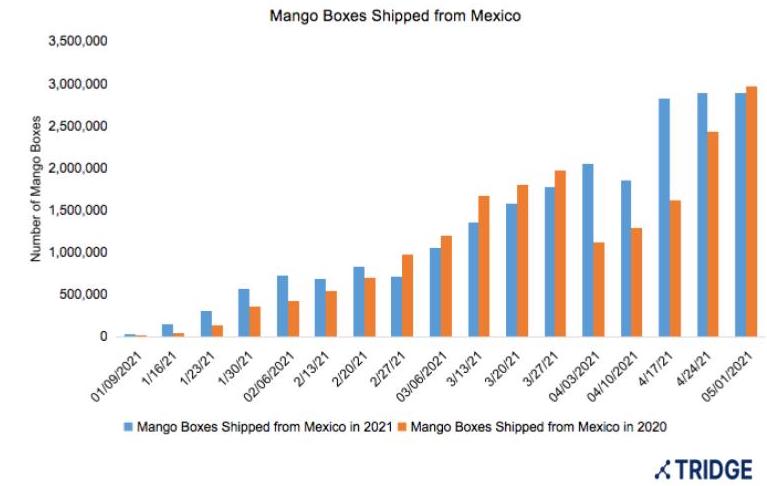Mango Updates for First half of 2021: Thailand, India, and Mexico
Thailand is the largest producer of mangoes and one of the top exporters in the world. In the last few months, mango sales have plummeted due to decreased demand in the global and domestic market. With only a few functional export packhouses, the farmers are forced to sell mangoes at low prices in the domestic market. Similarly, exports from India have also fallen due to high shipping charges. The country also continues to struggle with low mango prices as a consequence of lowered domestic demand. Mexican mango production was also impacted in Q2 due to lower than average rain during the main mango producing season, but exports remained consistent and are expected to record a year-to-year increase of 11%. As we approach the midpoint of 2021, lower domestic sales, exports, prices, and logistic issues continue to haunt these leading mango players.
Thailand
Nam Dok Mai is one of the most popular mango varieties in Thailand, both for domestic consumption and export. This variety has a sweet taste and golden color and is often referred to as “Barracuda Mangoes.” Ever since the pandemic hit Thailand, mango sales have plummeted due to decreased demand in the global and domestic market. The harvest season of Nam Dok Mai is complete by the end of April, which has increased the availability resulting in an oversupply. In the last six months, mango prices for Nam Dok Mai have plummeted from USD 3.75 per kg in December to USD 0.29 per kg in May as the supply picked up the pace.Since the beginning of the season, the mango industry of Thailand was expected to bear the burden of the pandemic. Only a few export packhouses are buying mangoes from the farmers, forcing them to sell mangoes at low prices in the domestic market and creating a glut.

Source: Tridge. Price Charts.
India
The second wave of COVID-19 and the main mango harvest season were overlapped, leading to a difficult time for the mango suppliers. As COVID-19 swept off in Maharashtra’s primary mango production, the government imposed a strict lockdown throughout the state. This was followed by a fall in domestic demand for mangoes, and lower prices for the most popular mango variety Alphonso crashed. One mango box contained 5-6 dozens of mango fell by 50% from USD 81.6 to USD 40.3. The main mango-producing regions have already borne the cost of treatments mandated for export varieties, labor, and transportation, further increasing the net losses for the farmers.

Source: Tridge Price Charts.
There was also a sharp dip in the Alphonso mango exports from India in the last few weeks in the face of restrictions imposed on flights from India. U.A.E and Europe are two of the biggest markets for Indian mango, which closed their borders to flights arriving from India in an attempt to protect their own country. Similarly, Indian mangoes are expected to be absent from retail markets in the U.S. as the two countries were unable to come up with a workable solution regarding inspections and certifications. Mango exports were also impacted by high cargo rates due to a shortage of containers across the world. The increased cargo prices made exporting mangoes overseas unviable for the small farmers.
Mexico
The Mexican mango season began the first week of January 2021 and is expected to run until the first week of October 2021. However, the mango industry faces a setback due to a lack of irrigation in Sinaloa, one of the main mango-producing regions. The farmers face various challenges due to lack of irrigation and are forced to carry heavy water buckets to the orchards. The lower than average rain has dried up the wells and deprived the mango orchards of water during the main mango growing season. The lack of an adequate amount of irrigation has reduced the quality and size of the mango. The lower quality mango is not fit for exporting and is sold at lower prices in the domestic market.
Despite the setback in one region, Mexico’s mango exports remained competitive to the numbers recorded in 2020. The country exported approximately 2,885,060 boxes by the end of week 17 for a total of 22,232,365 boxes for the season. The average mango boxes shipped by the end of week 17, 2021, was 15% more than the number recorded in 2020. It is expected by the end of the season, the mango exports will be 11% more than the number registered in the previous year.

Source: National Mango Board.Note: Boxes weigh 4kg - 4.5kg each.
Sources
- Mango Org. Mango Crop Report.
- Thai PBS. “Mango growers complain of low prices and fewer exports due to COVID-19.”
- The Indian Express. “No Indian mangoes in the US for the second year in a row after govts fail to come up with a solution.”
- The Print. “No juice in Alphonso again, 50% price fall makes the second wave worse for Maharashtra farmers.”
- Tridge. Price Charts.
- Tridge. Tridge Analysis. Mango Market Report.







